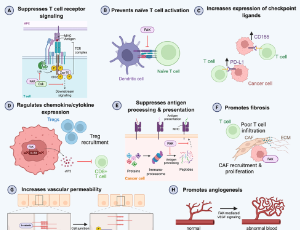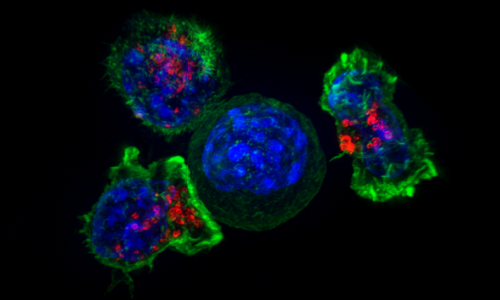Loading
Journal of Cancer Immunology
ISSN: 2689-968X


Sanjay K. Srivastava
Texas Tech University Health Sciences Center, USA
Featured Article
Targeting FAK to Potentiate Immune Checkpoint Therapy in Solid Tumors

Featured Article
Second-Line Systemic Therapies in Metastatic Renal Cell Carcinoma: Current Insights and Future Directions

Featured Article
Effects of Tumor-derived Small Extracellular Vesicles on T cell Survival in Patients with Cancer; A Commentary

About this Journal
The aim of Journal of Cancer Immunology is to publish exciting discoveries on interactive immunology of deadly disease called “Cancer”. The incredible influence of immune system on transformation and growth of tumour has always influenced basic and advanced investigations on cancer. The journal is established with the aim of reporting current updates to cancer research community. Journal features original and promising discoveries in cancer immunology as research, review, novel cases and case series, editorials, correspondence and perspectives after single blind peer review process.
Articles
Targeting FAK to Potentiate Immune Checkpoint Therapy in Solid Tumors
The advent of immune checkpoint inhibition revolutionized cancer care, yet many people will fail to respond due to innate or acquired resistance. Combination therapies with immune checkpoint inhibitors are being explored to enhance their efficacy and improve patient outcomes. Focal adhesion kinase (FAK), known for its roles in cell adhesion and migration, has emerged as a potential therapeutic target due to the identification of its additional functions in cancer progression, including its ability to establish a pro-tumorigenic, immunosuppressive microenvironment.
Adherent Natural Killer Cells De Novo Express IL-2Rα and Sustain Long-Lasting, Potent Anti-Tumor Activity in Picomolar Concentrations of IL-2
Natural killer (NK) cells are innate lymphoid cells (ILCs) that play key roles in immunosurveillance and immunoregulation. They constitute a heterogeneous population comprising three principal subpopulations: NK1 (cytotoxic), NK2 (regulatory), and NK3 (adaptive). In response to interleukin-2 (IL-2) stimulation, NK3 cells differentiate into adherent NK (A-NK) cells, which exhibit potent anti-tumor activity. Human A-NK cells are generated by priming and adherence-based selection of peripheral blood NK3 cells in nanomolar (nM) IL-2 concentrations, followed by prolonged restimulation and culture in the same IL-2 conditions.
Blood Clotting Contributes to a Malignant Glioma Phenotype: A Commentary
High-grade gliomas are malignant brain tumors that are derived from glial progenitors, oligodendrocytes or astrocytes. The prognosis of malignant glioma is poor with an overall survival of 12-15 months for glioblastoma (GBM) and 2-5 years for anaplastic glioma. A hallmark of glioma is the diffuse infiltration of the neuropil, which regularly prevents complete surgical removal even in premalignant lesions. While gliomas are generally considered to be non-metastatic, they are able to activate transcriptional programs known to promote mesenchymal cell functions that are associated with increased tumor cell invasion, a high rate of proliferation and poor patient survival.
AminoTricomplex Therapy in Advanced Triple-Negative Breast Cancer: A Translational Study Linking Survivin Downregulation, Cystatin C Upregulation, and MT1 Receptor Re-Expression to Clinical Outcomes
Breast cancer remains the most frequently diagnosed malignancy in women worldwide. TNBC—defined by the absence of estrogen receptor (ER), progesterone receptor (PR), and human epidermal growth factor receptor 2 (HER2)—comprises ~15–20% of cases and is disproportionately represented among younger women, women of African ancestry, and carriers of germline BRCA1 mutations.
Next-Generation Immune Checkpoint Inhibitors in Cancer: Mechanisms, Current Clinical Advances, and Future Directions
The introduction of immune checkpoint inhibitors (ICIs) targeting cytotoxic T-lymphocyte–associated protein 4 (CTLA-4) and later programmed cell death protein 1 (PD-1) or its ligand (PD-L1) marked a turning point in cancer therapy. These agents validated the principle that durable tumor control can be achieved by releasing inhibitory pathways that restrain antitumor T cell responses. Long-term survival benefits in melanoma, non-small cell lung cancer, and other malignancies have established immunotherapy as a defining development in oncology.
Expanding the Cancer Neoantigen Peptide Repertoire beyond In silico Tools
CD8+ cytotoxic T cells recognise and kill cancer cells that present immunogenic peptides bound to the cell surface major histocompatibility complex class I (MHC-I) molecules.
SHP2 Inhibition as a Promising Anti-cancer Therapy: Function in Tumor Cell Signaling and Immune Modulation
The protein tyrosine phosphatase SHP2, encoded by PTPN11, functions as a critical signal transduction regulator and interacts with key signaling molecules in both RAS/ERK and PD-1/PD-L1/ BTLA (B- and T-lymphocyte attenuator) pathways. Targeting SHP2 pharmacologically, therefore, may be a promising therapeutic strategy for many RAS-driven cancers.
Small-molecule Interferon Inducers for Cancer Immunotherapy Targeting Non-T cell-inflamed Tumors
Since the discovery of escaping mechanism of tumor from negative immune regulation, the paradigm of drug discovery for anti-cancer agents has been dramatically shifted to cancer immunotherapy (e.g., dendritic cell therapy, CAR-T cell therapy, or antibody therapy) by stimulating patient’s immune system to treat cancer.
Emerging Strategies to Attack Polyploid Cancer Cells
Polyploid cancer cells can arise de novo in tumors or they can be induced by therapeutics that inadvertently increase the rate of cytokinetic failure. These cells portend a poor outcome in many cancers because polyploid cancer cells can undergo error prone reductive cell divisions to yield aneuploid progeny. The immune system has evolved mechanisms by which it can specifically recognize and remove polyploid cancer cells, but these appear to be tampered with malignancy so that polyploid cells can persist and fuel the development of cancer cell clones that are resistant to therapeutics and have metastatic potential.
Mitochondria Autoimmunity and MNRR1 in Breast Carcinogenesis: A Review
We review here the evidence for participation of mitochondrial autoimmunity in BC inception and progression and propose a new paradigm that may challenge the prevailing thinking in oncogenesis by suggesting that mitochondrial autoimmunity is a major contributor to breast carcinogenesis and probably to the inception and progression of other solid tumors. It has been shown that MNRR1 mediated mitochondrial-nuclear function promotes BC cell growth and migration and the development of metastasis and constitutes a proof of concept supporting the participation of mitochondrial autoimmunity in breast carcinogenesis.
Inference of Clonal Copy Number Alterations from RNASequencing Data
Tissues are composed of various types of interacting cells [1]. To understand the cellular organization and function in tissues, it is necessary to identify all of the different cell types and the locations of these different cell types within tissue structures. The transformative advances in experimental and computational methods will help us to build the complex map of the tissues and study how tissue organization influences the cell’s molecular state and interactions in healthy and diseased tissue.
Emerging Potential of Plant Virus Nanoparticles (PVNPs) in Anticancer Immunotherapies
Plant virus nanoparticles (PVNPs) are increasingly recognized and studied for use in biomedical applications. PVNPs include plant virions with self-assembled capsid protein coats (PC) that encapsulate the virus genome, and virus-like particles (VLPs), a capsid without the viral genome.
Humanized Chimeric Antigen Receptor (CAR) T cells
In 1989, researchers proposed an intricate strategy in the field of adoptive cell therapy (ACT). Using the T-cell receptor (TCR) as a template, they replaced the coding sequence for the Vα and Vβ chains with the antigen- recognition domains from an antibody (VH and VL chains).
Immune Checkpoint Inhibitors in the Management of Urothelial Carcinoma
Bladder cancer is one of the most common and expensive cancers in the United States, with an expected 81,400 new cases and 17,980 deaths in 2020 alone. The incidence is increased among white men and diagnoses often occur in the 7th decade of life.
Cervical Cancer Prevalence in sub-Saharan Africa and HPV Vaccination Policy: A Public Health Grand Challenge?
“Women are not dying because of diseases we cannot treat. They are dying because societies have yet to make the decision that their lives are worth saving.”
Immunogenic Cell Death: A Step Ahead of Autophagy in Cancer Therapy
Cell Death has long been considered to be an inevitable part of the life cycle of a cell and hence, considered a familiar consequence of cellular life.
SHP2 Inhibition as a Promising Anti-cancer Therapy: Function in Tumor Cell Signaling and Immune Modulation
The protein tyrosine phosphatase SHP2, encoded by PTPN11, functions as a critical signal transduction regulator and interacts with key signaling molecules in both RAS/ERK and PD-1/PD-L1/ BTLA (B- and T-lymphocyte attenuator) pathways. Targeting SHP2 pharmacologically, therefore, may be a promising therapeutic strategy for many RAS-driven cancers.
Effects of Tumor-derived Small Extracellular Vesicles on T cell Survival in Patients with Cancer; A Commentary
Tumor-induced immune suppression has been recognized as one of the major barriers for cancer immune therapies, including checkpoint inhibitors. Immunosuppressive mechanisms that tumors utilize to silence anti-tumor immune cells are numerous and differ between tumor types.
Phosphopeptide Neoantigens as Emerging Targets in Cancer Immunotherapy
Protein post-translational modifications play a vital role in various cellular events essential for maintaining cellular physiology and homeostasis. In cancer cells, aberrant post-translational modifications such as glycosylation, acetylation, and phosphorylation on proteins can result in the generation of antigenic peptide variants presented in complex with MHC molecules. These modified peptides add to the class of tumor-specific antigens and offer promising avenues for targeted anti- cancer therapies. In this review, we focus on the role of phosphorylated peptides (p-peptides) in cancer immunity.
Aromatase Inhibitors and their Connection to Autoimmunity
The aromatase inhibitors (AIs) anastrozole, letrozole, and exemestane are often prescribed as endocrine therapy for patients with estrogen receptor–positive breast cancer. AIs are associated with musculoskeletal side effects such as bone loss, arthralgias, myalgias, and tenosynovitis. Notably, exemestane is a steroidal AI and both anastrozole and letrozole are non-steroidal AIs.
Perioperative Immune Checkpoint Blockade for Muscle-Invasive and Metastatic Bladder Cancer
Checkpoint inhibitors offer promise in treating muscle-invasive and metastatic bladder cancer, but the optimal timing of their administration—neoadjuvant or adjuvant—remains unclear. To determine the efficacy of combining checkpoint inhibition with standard cisplatin-based chemotherapy, we conducted a phase II trial of neoadjuvant anti-PD-1 (αPD-1) and anti-CTLA-4 (αCTLA-4), in combination with cisplatin-gemcitabine, for patients with muscle-invasive bladder cancer prior to radical cystectomy.
Enhancing the Efficacy of CAR-T Cell Therapy: A Comprehensive Exploration of Cellular Strategies and Molecular Dynamics
The emergence of chimeric antigen receptor T cell (CAR-T cell) therapy has revolutionized cancer treatment, particularly for hematologic malignancies. This commentary discusses developments in CAR-T cell therapy, focusing on the molecular mechanisms governing T cell fate and differentiation. Transcriptional and epigenetic factors play a pivotal role in determining the specificity, effectiveness, and durability of CAR-T cell therapy.
The Role of Tumor and Host Microbiome on Immunotherapy Response in Urologic Cancers
The role of the microbiome in the development and treatment of genitourinary malignancies is just starting to be appreciated. Accumulating evidence suggests that the microbiome can modulate immunotherapy through signaling in the highly dynamic tumor microenvironment. Nevertheless, much is still unknown about the immuno-oncology-microbiome axis, especially in urologic oncology. The objective of this review is to synthesize our current understanding of the microbiome’s role in modulating and predicting immunotherapy response to genitourinary malignancies.
About Scientific Archives
Scientific Archives is a global publisher initiated with the mission of ensuring equal opportunity for accessing science to research community all over the world. Spreading research findings with great relevance to all channels without any barrier is our goal. We want to overcome the challenges of Open Access with ensured quality and transparency.

